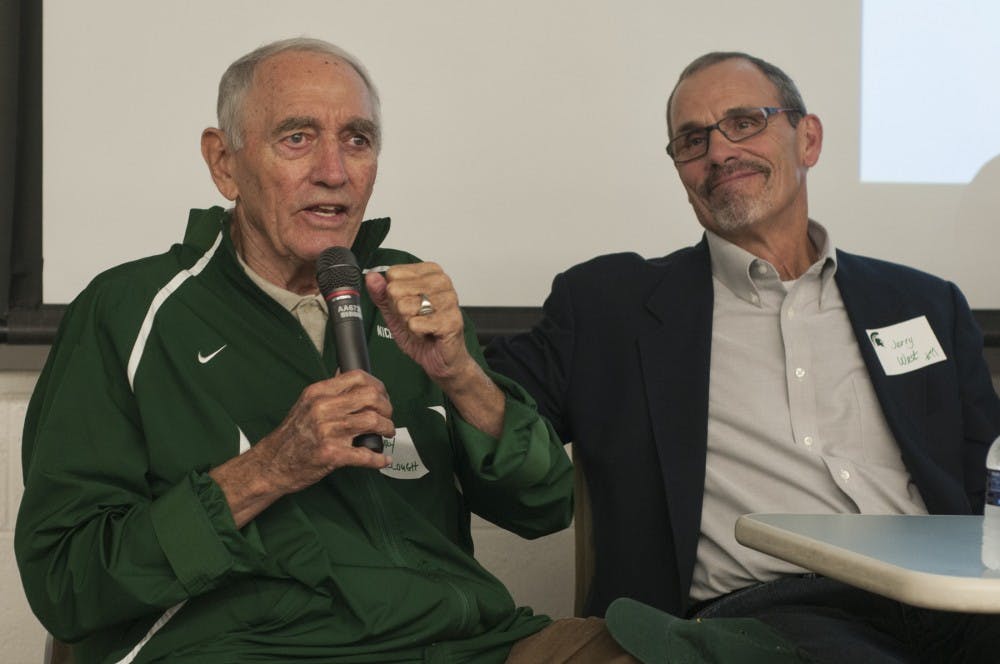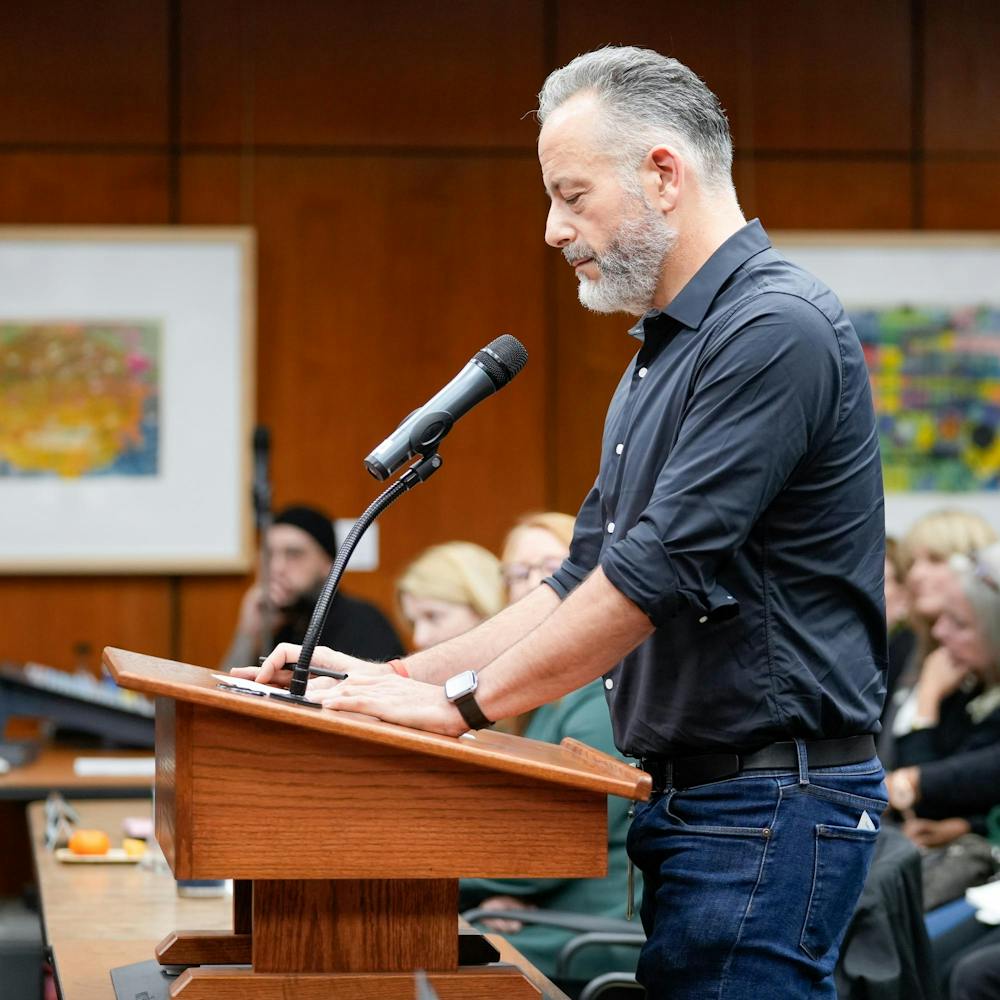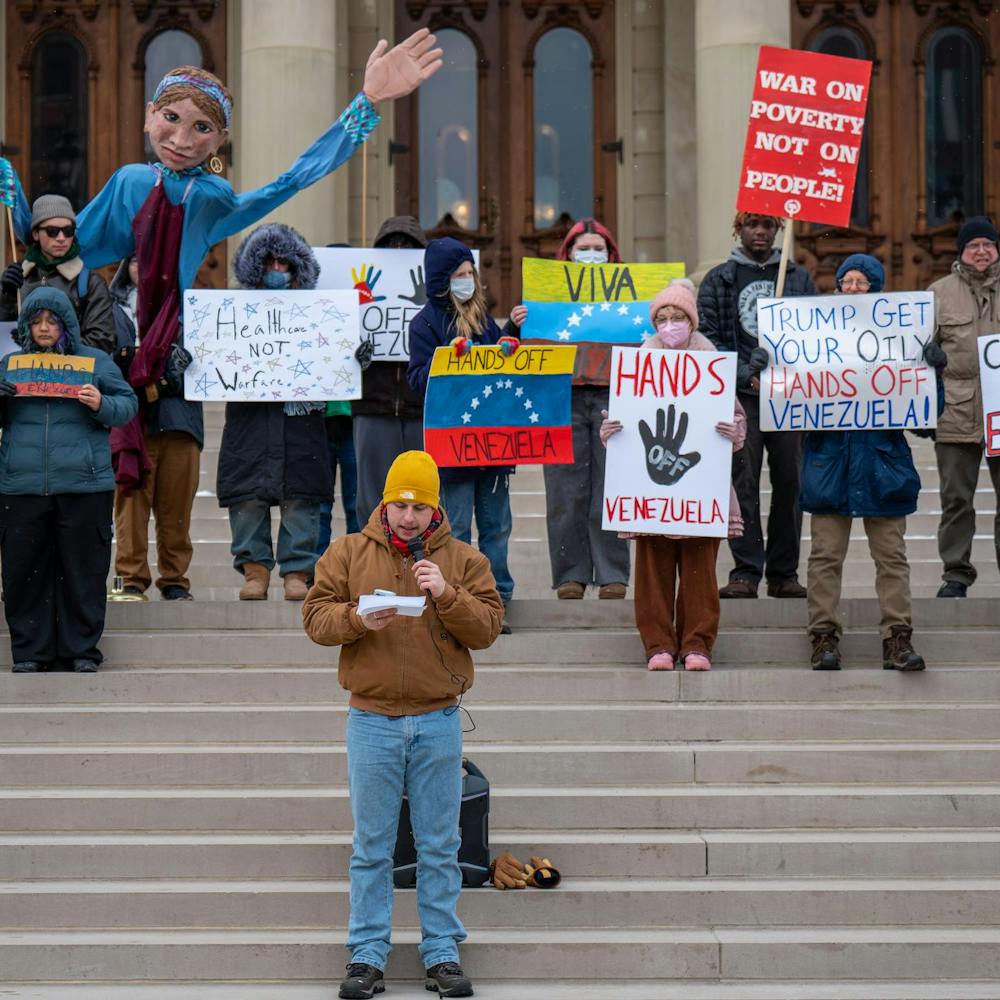If it weren’t for a 10-10 tie on a cloudy and a biting November day in 1966, the seven men sitting in the front of 101 Conrad Hall wouldn’t have been there. Not many would care about their legacy had the score been decisive.
“Because of that tie Ara Parseghian told us at our 25th anniversary, if we had won that game, that game wouldn’t have been talked about,” George Goeddeke, a Detroit native who played for Notre Dame, said. “Or if Michigan State had won it, forget about it.”
But no one has and no one probably ever will.
On Wednesday night MSU’s Sterling Armstrong, Jimmy Raye, Regis Cavender, Bob Apisa, Jerry West, Henry "Hank" Bullough and Notre Dame’s Goeddeke sat down to discuss the legacy of the Game of Century in an event put on by the MSU University Archives and Historical Collections.
MSU football was ranked No. 2 in the country in 1966 and fought to a 10-10 tie against No. 1 Notre Dame in what was ultimately dubbed the Game of the Century.
Throughout the night, the collection of players and coach Bullough recounted tales of the game, hitting on the atmosphere of the week and the ferocity of the matchup.
“I had butterflies on Monday night before the ball game,” Goeddeke said. “Normally that was a Friday night event.”
The game, broadcast on national TV, was pegged the Game of Century from the get-go, as both teams raced out to undefeated records. MSU was coming off a national title-winning season and Notre Dame was looking to capture one for the first time since the 1940s.
The hype on both campuses was palpable for both teams especially for now deceased Bubba Smith. Raye, quarterback for MSU and first black quarterback from the south to start in college football, was a key friend to Smith.
Raye said he remembers riding along with Smith around campus watching Smith flaunt his status as the star of the program. He remembers riding around in Smith’s car watching Bubba taking pictures, shaking hands and stopping traffic, but above all being stopped by police as Smith had incurred thousands in parking tickets.
The police took Smith to the station, leaving Raye with the car.
“I drove the car back to the Kellogg Center and (Smith) told me to call Biggie (Munn) and tell him to get him out of jail,” Raye said to roars of laughter.
Most of the group, 70 years old, older than or nearing 70, shared memories of plays, feelings and thoughts all in vivid recollection to the scores of people gathered in Conrad Hall.
Armstrong flawlessly recalled a play in which he intercepted the football, only for it to be called back on an offsides call on Smith. He later recalled being nervous as he said his name on national television during player introductions.
“That was the first big moment of the game for me,” Armstrong said.
Apisa, a native of Hawaii who was injured and did not play against Notre Dame, recalled the great debt he felt he owed MSU for being able to bring Hawaii “into the 20th century.” The game was the first live broadcast to the islands, and Hawaii has been receiving them ever since.
“As I’ve said before, the state of Hawaii, always a great debt of thanks to this university, to this team,” Apisa said.
The game was a hard-hitting affair mixed with a near-freezing temperature that provided the scene to the football game. Many players said they didn’t notice the cold, except Raye, who hails from North Carolina.
“It was probably the coldest day in East Lansing, in the history of the state,” Raye said, drawing more laughter. “And to have Jim Lynch and Alan Page try to knock my head off and trying to avoid those (guys)”
MSU charged out to a 10-7 lead that day in the first half behind a touchdown by Cavender, who had separated his shoulder in the game the play prior. He couldn’t even get off the field before the next play was called in.
Support student media!
Please consider donating to The State News and help fund the future of journalism.
“The shoulder pad was actually crushed — it looked like it was together with the glue and the fabric, but it looked like the backlight of a car window, how it shatters in the winter time,” Cavender said. “They called my play next and we scored.”
Notre Dame charged back to tie the game, leaving it unsettled as to who the national champion would be. They later split the national championship.
But the legacy of the game has taken on a much higher meaning once broken down. As fierce as the competition was, the still found respect for each other in the end.
Goeddeke recalled competing in the North-South showcase game with players from both teams, adding they forgot about the rivalry in those moments.
“We’re sitting in a hotel room in Miami after that 10-10 tie, singing Christmas carols having a brewski or two,” Goeddeke said. “We would fight to the death, but that was the camaraderie we had off the field.”
Apisa shared the same feelings of mutual respect.
“We have a great respect for him,” Apisa said of Goeddeke. “I do, his teammates and we do.”
Largely forgotten in the telling of the game was the backdrop of the turmoil of the 1960s. With a gaping racial divide and strong opposition to the Vietnam War, the game became almost a bright spot.
But it carried even greater weight for MSU, which had begun integrating its teams years earlier. The team was founded on respect for one another, it didn’t matter if the guys on the team were black or white, they were a family.
“Over the years I’ve cherished those relationships and friendships and they have endured the last 50-plus years because of the camaraderie and the love we had for one another,” Raye said. “The come into bonding the coming together for a common cause, regardless of race or ethnicity or religion or whatever, we were together to win football games and to play as one.
“That’s something to be proud of, particularly with the climate of the country at that time.”
Discussion
Share and discuss “Game of the Century lives on in former MSU players” on social media.







